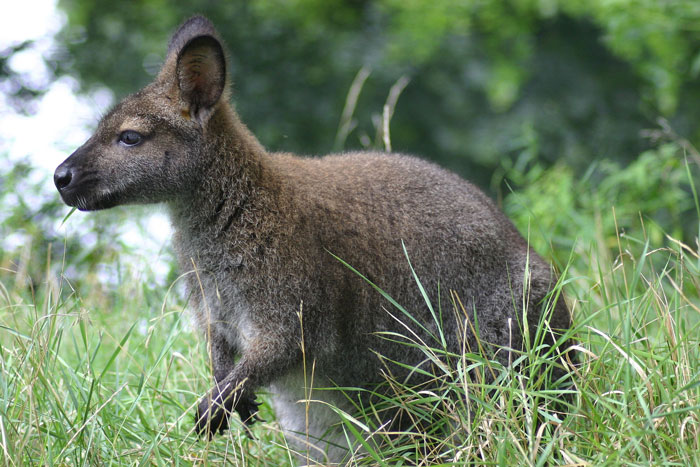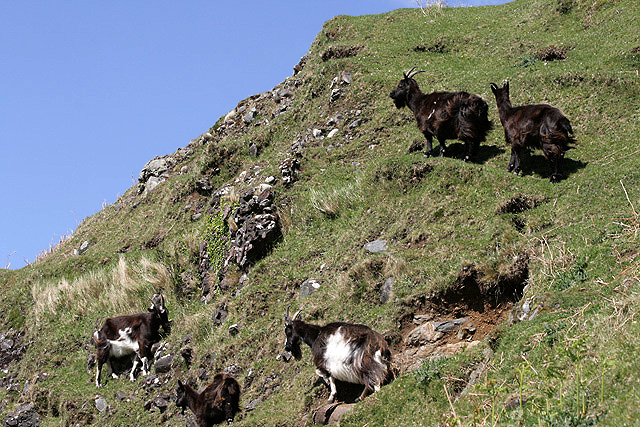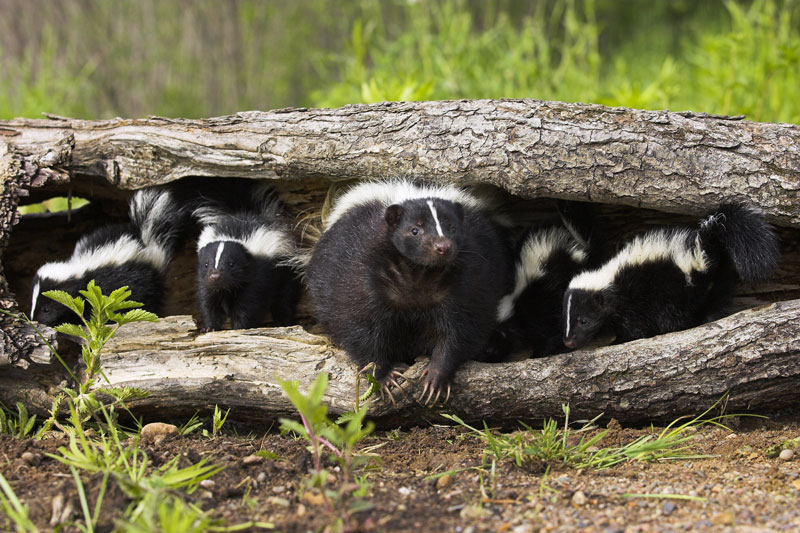When you #GetOutside in the UK, you expect to see plenty of native birds, squirrels and rabbits, and if you are lucky a roe deer or even a badger – but there are plenty of weird and wonderful wild animals if you know where to look…
Wallabies: Inchconnachan Island, Loch Lomond, Scotland (and others)

Red-necked wallaby by Grendelkhan (Creative commons)
Wallabies look like kangaroos, but are smaller – generally around knee height. They are marsupials, carrying their young in pouches, and originate on the eastern coast of Australia.
You can find red-necked wallabies living wild on a small island in the middle of Loch Lomond. They were deliberately introduced by a previous owner, Lady Arran Colquhoun, in the 1920s and have successfully lived there since.
Wallabies are living elsewhere as well: there is a small colony on the Isle of Man (descended from a pair that escaped a local wildlife park), and there have been occasional sightings in Ashdown Forest, Norfolk, Buckinghamshire and the Peak District.
Feral Goats: Snowdonia, Wales and Scottish Highlands

Feral goats on Kerrera © Walter Baxter (Creative Commons via Geograph)
Feral goats are probably descended from a crossbreed of escaped domesticated goats and the original wild inhabitants. Tough and agile, they are able to thrive in harsh mountain environments such as Snowdonia and the Scottish Highlands.
At a distance, they can be easily mistaken for sheep, but goats tend to walk with their tails up, rather than down as sheep do. Goats can often be spotted in small herds grazing or resting and will generally avoid humans. However, in some areas their natural curiosity and lack of fear in the absence of hunting will lead them to come right into your camp.
More on British Primitive Goats.
Wild Boar: Exmoor, New Forest and East Sussex

Adult wild boar are potentially dangerous if approached…
… but the piglets are seriously cute!
Wild Boar were hunted to extinction in the UK several centuries ago – but escapees from farms are recolonising some of the areas they vanished from. Not everyone is happy – a sounder of boars can make a mess if they get into a garden, and they can be aggressive to walkers straying onto their territory.
With males weighing more than the average human and sporting some nasty tusks, it’s best to keep a reasonable distance.
However, you can’t deny that the striped piglets, born in spring, rate very highly on the cute scale.
Coati: Lake District, England

Coati are strong climbers
Coati are members of the racoon family, and look similar with long bushy tails and a flexible snout. There are a small number thought to be living wild and breeding in the Lake District, probably from escaped pets.
Coati’s are diurnal (active during the day) and omnivorous, so you may be lucky enough to spot one digging for worms or searching for fruits.
Keep an eye out for their distinctive, bushy tails which are help up in the air as they walk.
www.thewestmorlandgazette.co.uk/news
Coypu: East Anglia

An adult coypu could be up to 70cm nose to tail, and weigh 17kg
Looking like something that is a cross between a giant rat and a monster guinea pig, the Coypu was introduced for fur farms in the 1930’s. They are thought to have been eradicated – so if you spot something that looks way too big to be a rat or water-vole DEFRA will want to know.
You can distinguish a coypu from a beaver by its distinctive bright orange teeth.
If you are a fan of classic kids film ‘The Princess’ Bride’, you may recognise the Coypu as being pretty close to the ROUS, although the real one spends more time in lakes and streams, and less in fire swamps.
Striped Skunk: Forest of Dean

Cute – but very smelly!
Thought to be escaped or released pets, the Striped Skunk is best known for being able to squirt really nasty smelling liquid at anything it considers a threat.
Aside from the smell, they apparently make good pets, as they are easy to train and care for, but removal of their scent glands was banned in the UK in 2007, leaving only those willing to deal with a smell that’s a cross between garlic, burning sulphur and sewer gas as potential owners.
If you do spot a skunk, we’d suggest you do not startle them, and keep any dogs well away unless you want to go home with all the windows open.
www.telegraph.co.uk/skunk-pack
Beavers: Scotland, Wales, Devon & Kent

Beavers working on a new damn
Beavers were native to the UK, but were hunted to extinction in the 16th century due to demand for their fur, meat and scent glands (used for perfumes and as a food additive).
They are now being reintroduced to various locations around the country. It’s hoped that the damns created by the beavers will reduce flooding and improve water quality. The pools created can slow down water flow during heavy rain, and create a place for silt and sediment to settle, and for other wildlife to make a home.
If you spot distinctive gnaw marks on trees, or come across a large pile of wood blocking a stream, keep your eyes open and you may spot one of these either in or out the water.
www.wildlifetrusts.org/beaver-projects
Parakeets: London

Ring-necked parakeet on a feeder in London ©Christine Matthews (Creative Commons via Geograph)
These colourful birds have long been favourites as pets, but recently have managed to create a successful breeding population, especially in London. Estimates of their numbers vary, but there could be up to 50,000 centred in the warmer dryer climate of the south-east.
Despite their looks, not everyone is happy about their population explosion. Large flocks can be noisy, and some native species may find it harder to complete for food.
The most successful are the ring-necked parakeet, but some other members of the parrot family seem to be beginning to live wild in the UK as well, so if you spot a sudden flash of colour, you may well have found one of the exotic invaders.
www.rspb.org.uk/ringneckedparakeet
Siberian Chipmunk: various locations

Being invaded has never been this cute before (Siberian Chipmunk © Frank Vassen, Creative Commons)
Siberian chipmunks look a lot like squirrels, but with distinctive brown and white stripes extending from nose to tail. As the name suggests, they are common in Russia and Siberia, but are a highly invasive species and have been spreading across Europe.
They are quite popular pets, so it’s thought that the individuals spotted in various locations are escaped pets, and not yet breeding in the wild. However, due to the potential ecological impact on native species, this is another animal DEFRA would like to be notified of when spotted.
www.nonnativespecies.org/chipmunk
Feral Ferrets: Wales

Escaped pet ferrets can survive in the wild
The ferret is a domesticated form of the polecat. About twice the size of a rat, their long slim bodies are ideal for squeezing down rabbit holes, chasing the rabbits to trappers waiting at the other entrances to the burrow.
Nowadays they are mostly kept as pets, rather than working animals – they are curious, intelligent and can be trained or even walked on a lead. They come in a variety of colours, but white markings are common, making them easy to spot.
Feral ferrets are generally escaped pets. They don’t tend to survive well as their cousin, the polecat, is far better at catching prey, but a small population is regularly spotted around Snowdon.
They can cross-breed with polecats and after one or two generations tend to revert to dark colouring.
www.snowdoniamammals.co.uk/feralferret
Keep an eye out for part two coming soon for more cute, weird and frankly terrifying animals you would not expect to see while out for a walk in the British countryside.
How many of these have you spotted? Tell us in the comments below.





